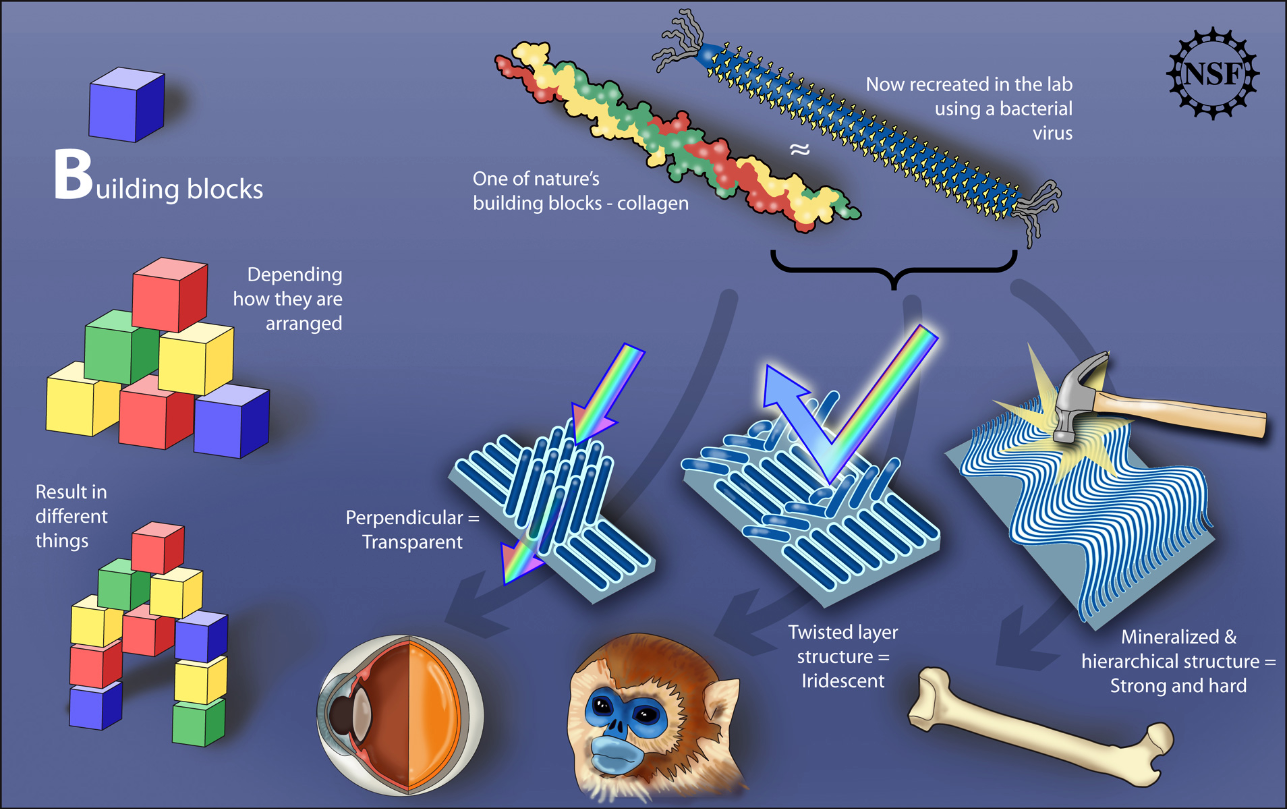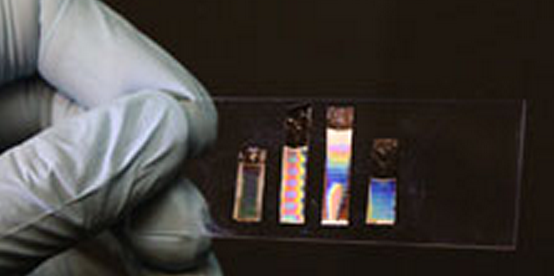Making building blocks from viruses
October 24, 2011

New virus-based materials reveal different textures and different properties for reflecting light (credit: University of California at Berkeley)
Using a simple single-step process, engineers and scientists at the University of California at Berkeley recently developed a technique to direct benign, filamentous viruses called M13 phages to serve as structural building blocks for materials with a wide range of properties.
By controlling the physical environment alone, the researchers caused the viruses to self-assemble into hierarchically organized thin-film structures, with complexity that ranged from simple ridges, to wavy, chiral strands, to truly sophisticated patterns of overlapping strings of material — results that may also shed light on the self-assembly of biological tissues in nature.

This illustration reveals how the arrangement of molecular building blocks results in materials with unique properties, both in nature and in the laboratory (credit: Zina Deretsky, National Science Foundation)
“We are very curious how nature can create many diverse structures and functions from single structural building blocks, such as collagens for animals and celluloses for plants,” University of California at Berkeley bioengineer Seung-Wuk Lee said.
The fundamental unit of the novel films is the bacteria-hunting virus, M13. In nature, the virus attacks Escherichia coli (E.coli), but in bioengineering laboratories, the virus is emerging as a nanoscale tool that can assemble in complex ways due to its long, slender shape and its chiral twist.
How to make biomimetic structures
In the Berkeley lab, the viruses are suspended in a buffered salt solution. Engineers dip a thin substrate into it, allowing the viruses to adhere to the substrate. By varying the speed at which they withdraw the substrates from the virus-rich solution, the concentration of viruses in the solution, and the ionic concentration, the researchers are able to craft three distinct categories of films.
The simplest film consisted of alternating bands of filaments, with the viral filaments in each band oriented perpendicular to the filaments in the adjacent band. IncreasING the concentration of viruses in the solution adds more physical constraints to each filament’s movement within its environment.So the filaments bunch together into helical ribbons. With even higher concentrations, the withdrawal yields ever more complex, yet ordered, bundles of filaments that the researchers referred to as “ramen-noodle-like.”
By varying their techniques, the researchers can alter the physical environment for the viral filaments, ultimately forcing the viruses to align into the highly specialized structural films. Each film is different in color, iridescence, polarity ,and other properties.
The researchers believe the hierarchical nature of the structures reflects the hierarchical growth patterns of similar biomolecules in nature, processes that result in chiral materials, like collagen, expressing themselves as the building blocks of a cornea in one level of self-assembly and the building blocks of skin tissue at a more complex level. Such self-assembly yields stunning macroscale structures — for example, skin tissue that appears blue on birds and blue-faced monkeys is actually not expressing the light absorption from blue pigment, but the blue light scattered by complex arrays of chiral, molecular building blocks.
“We strongly believe that our novel approach to constructing biomimetic ‘self-templated’, supramolecular structures closely mimics natural helical fiber assembly,” says Lee. “One important reason is that we not only mimicked the biological structures, but we also discovered structures that have not been seen in nature or the laboratory, like the self-assembled ‘ramen-noodle structures’ with six distinct order-parameters.”
The films can also serve as biological substrates. The team was able to grow sheets of cells that were oriented based on the texture of such substrates, with one variation incorporating calcium and phosphate to create a biomaterial similar to tooth enamel.
According to National Science Foundation Biomaterials program director Joseph Akkara, “the reported approaches could be used to investigate mechanisms for diseases such as Alzheimer’s, which is caused by amyloid aggregation in our brain tissues. More broadly, the breakthroughs could potentially yield scientific impacts in the area of tissue regeneration and repair.”
Ref.: Woo-Jae Chung, et al., Biomimetic self-templating supramolecular structures, Nature, 2011; [DOI:10.1038/nature10513]